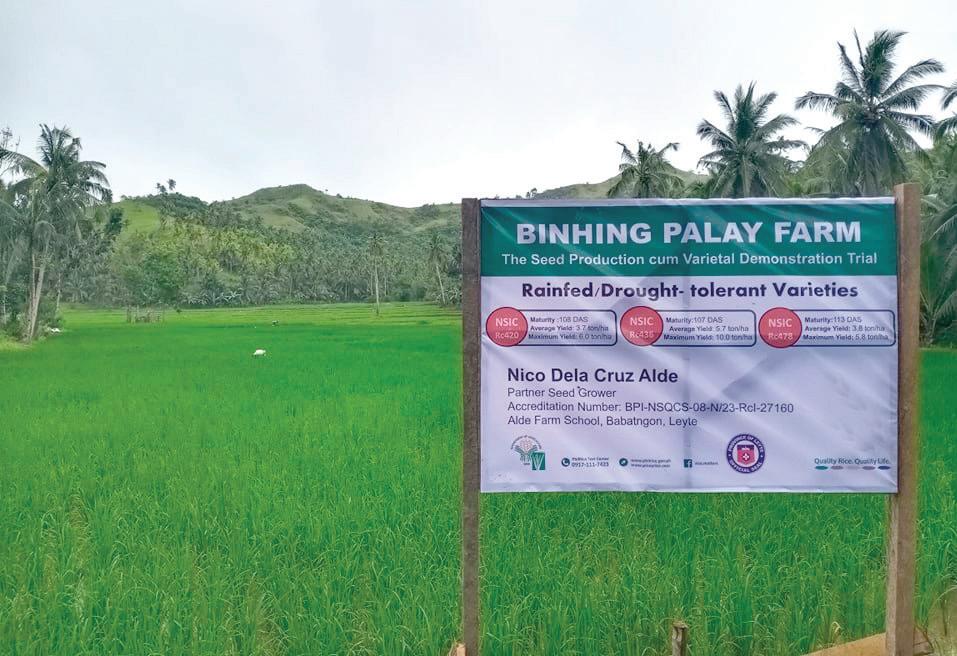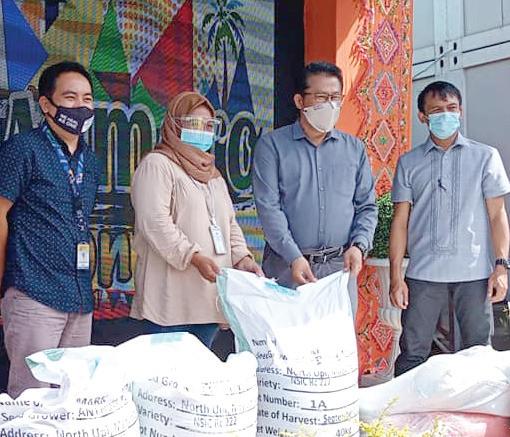
4 minute read
RICE ACROSS THE COUNTRY
from Magazine 2021 1Q
by LearnPH
COMPILED BY: JULIANNE A. SUAREZ

Advertisement
DA-PHILRICE AGUSAN

Belen M. Tabudlong
DA-PHILRICE BATAC
Cynthia May O. Lapat
DA-PHILRICE BICOL
Biopesticides developed
Biological control agents (BCA) that help reduce rice pest populations without harming humans and the environment are shaping up in the station.
Being maintained are two local strains of biological control organisms (BCO) – the green (Metarhizium anisopliae) and white (Beauveria bassiana) muscardine fungi from naturally infected rice black bug and rice bug hosts. These BCOs infest and kill certain rice insect pests.
Studies have shown that the BCOs are ideal because of their high efficiency, safety to non-target organisms, ease of production using locally available materials, and low-cost application.
The BCA technology is under observation in uncontrolled environments and outside laboratory facilities to assess the longevity and virulence of the beneficial fungi.
Trainers trained
The Rice Competitiveness Enhancement Fund-Rice Extension Services Program has trained 26 agricultural extension workers, local farmer-technicians, and farm school owners and workers from Ilocos Norte, who will, in turn, train farmers.
The training on the production of highquality inbred rice and seeds and farm mechanization was done in two batches on Nov. 9-20 and Dec. 7-18, 2020.
Crop insurance and basic financial management discussions were respectively handled by the Philippine Crop Insurance Corporation and the Development Bank of the Philippines. -
DEEJAY JIMENEZ
Rice-producing areas in Caraga, Northern Mindanao, and Davao regions are seen to benefit from these biopesticides.
- MARELIE D. TANGOG
More demo farms
More demonstration farms will be set up to produce high-quality inbred rice seeds (HQiS) for Bicolano and Bisaya farmers. As of Dec. 2020, 11 Binhing Palay farms had been established in Albay, Camarines Sur/ Norte, Sorsogon, Masbate, Catanduanes, Samar, and Leyte. Thirteen varieties were showcased in these farms and results have it that the use of HQiS increased yield by 10%.
“Binhing Palay farms help us establish areas that can supply HQiS of new and promising varieties, which can then be recommended to the provinces,” said Rona T. Dollentas, soil science expert and the station’s R&D coordinator.
HQiS usage in the Bicol Region is only 30%; 31% in Eastern Visayas, according to regional DA authorities. This means that majority of farmers are using the informal seed system that does not guarantee the good quality of
seeds. - MICHAEL L. SATUITO

DA-PHILRICE ISABELA

Hybrid rice showcased
DA-PhilRice, together with private seed companies, established technology demonstration (techno-demo) farms on hybrid rice nationwide this 2021 dry season in support of the DA’s Rice Resiliency Project under its Plant, Plant, Plant Program. The 19 techno-demo farms comprise a total area of 13ha showcasing the public hybrids Mestizo 1 or M1 (PSB Rc 72H) and Mestiso 20 or M20 (NSIC Rc 204H), which respectively mature in 123 and 111 days, average 5.4 and 6.4t/ha, with maximum yields of 9.9 and 11.7t/ha. The branch station is part of the 12th National Rice Technology Forum that showcases hybrid rice and other
Hanah Hazel Mavi B. Manalo DA-PHILRICE MIDSAYAP
technologies in Cauayan City, Isabela. The Institute also joined four provincial hybrid rice derbies in llocos Norte, Ilocos Sur, and Pangasinan. It also helped put up eight hybrid rice technodemo farms at the Tarlac Agricultural University in Camiling; Central Luzon State University in the Science City of Munoz, Nueva Ecija; Quirino State University in Diffun; Isabela State University in Echague; Nueva Vizcaya State University in Bayombong; and Cagayan State University in Piat, Sanchez Mira, and Gonzaga. Six hybrid techno-demo farms are located at the Institute’s stations in Nueva Ecija, Isabela, Albay, Negros Occidental, North Cotabato, and Agusan del
Norte.- HANAH HAZEL MAVI B. MANALO
Rice seeds for BARMM
DA-PhilRice Midsayap graced the ceremonial distribution of inbred rice seeds to farmers during the 2nd Founding Anniversary of the Bangsamoro Autonomous Region in Muslim Mindanao (BARMM), Jan. 12. Senior development staffer Ommal H. Abdulkadil said the gesture is a testament to the steadfast partnership of the station and the BARMM Ministry of Agriculture, Fisheries, and Agrarian Reform in support of the region’s rice industry. For the 2021 wet season, qualified rice farmers in Maguindanao and Lanao del Sur will receive in March-April around 40,000 bags of high-quality inbred seeds from the Rice Competitiveness Enhancement Fund-Seed
Program.- - SYLVIA THERESE C. QUIRING

Maria Sofia M. Canilao
Photo: Nico D. Alde

DA-PHILRICE LOS BANOS DA-PHILRICE NEGROS
Rice appreciated
That they may be equipped with the basic technical knowledge about rice and rice production, 27 newly hired non-technical personnel participated in the “Appreciation Course in Rice Science and Technology” offered on Sept. 14-18 and Sept. 28-Oct. 2, 2020.
The new recruits were taught about the PalayCheck System, Palayamanan Plus, and rice farming and mechanization. Complementary hands-on activities were included to contextualize the trainees’ learning
experience. - RUBY MOSELLE O. TUMANGUIL
Organic rice supported
Current research on organic rice production is after increased productivity and profitability of its producers in the Visayas. Senior researcher Alvin D. Palanog said the study he leads will allow the Negros provinces, Iloilo, and Bohol to benefit from guidelines in organic rice production that the research will standardize.
“The research will help recommend institutionalized guidelines for organic farm certifications,” he said. Palanog added the study would also identify the best practices of farmers and develop appropriate management approaches for organic rice production. “Once we put together the best management practices, we could share them to farmers who would want to shift to organic farming,” he said. Palanog contended that producing organic rice offers higher profits to farmers and health advantages to its
eaters. - VANESSA A. TINGSON








